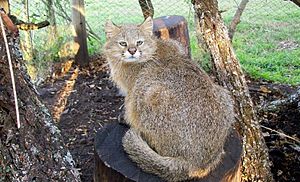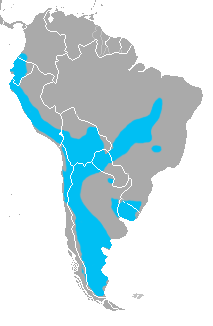Pampas cat facts for kids
Quick facts for kids Pampas cat |
|
|---|---|
 |
|
| Conservation status | |
| Scientific classification | |
 |
|
| Synonyms | |
|
The pampas cat (also called gato de las pampas) is a small wild cat. It lives in the Andes mountains in South America. You can find these cats in countries like Argentina, Chile, Bolivia, Peru, Uruguay, Brazil, Ecuador, and Colombia.
Some scientists think there are actually three different types of pampas cats: L. colocolo, L. braccatus, and L. pajeros. Other scientists believe they are all just one species.
Contents
Where do pampas cats live?
Pampas cats live in many different kinds of places. They can be found in cloud forests, wet swamps, dry scrublands, and open grasslands. This shows how adaptable they are to various environments.
What do pampas cats eat?
These cats mostly hunt small rodents, like guinea pigs and mice. But they also catch birds, such as flamingoes. Scientists have even seen pampas cats visiting penguin nests to eat eggs and baby penguins! Farmers sometimes report that these cats can also hunt larger animals like goats and chickens.
How big are pampas cats?
A pampas cat's body is usually between 42 and 79 centimeters (about 1.4 to 2.6 feet) long. Their tail adds another 22 to 33 centimeters (about 0.7 to 1.1 feet) to their length. They typically weigh between 3 and 4 kilograms (about 6.6 to 8.8 pounds).
Their fur is thick and long. It can be different colors, from pale yellow to dark gray-brown or even a dull red. Some pampas cats have stripes or spots, while others do not. They almost always have rings on their legs and tail.
Why are pampas cats important?
In most countries where the pampas cat lives, it is against the law to kill them. The pampas cat is considered "Near Threatened," which means it could be in danger of dying out. This is mainly because humans are using the land where these cats live for farms and other developments.
Native people in South America often respect the pampas cat. They see it as a sign of fertility (meaning it helps things grow and reproduce). They also believe that killing a pampas cat brings bad luck. However, some groups also use parts of the cat, like its skin, for special ceremonies.
First sightings on camera
The very first time pampas cats were filmed or photographed in the wild was in 2006. This was an important moment for scientists studying these shy animals.
Images for kids
See also
 In Spanish: Colocolo para niños
In Spanish: Colocolo para niños






